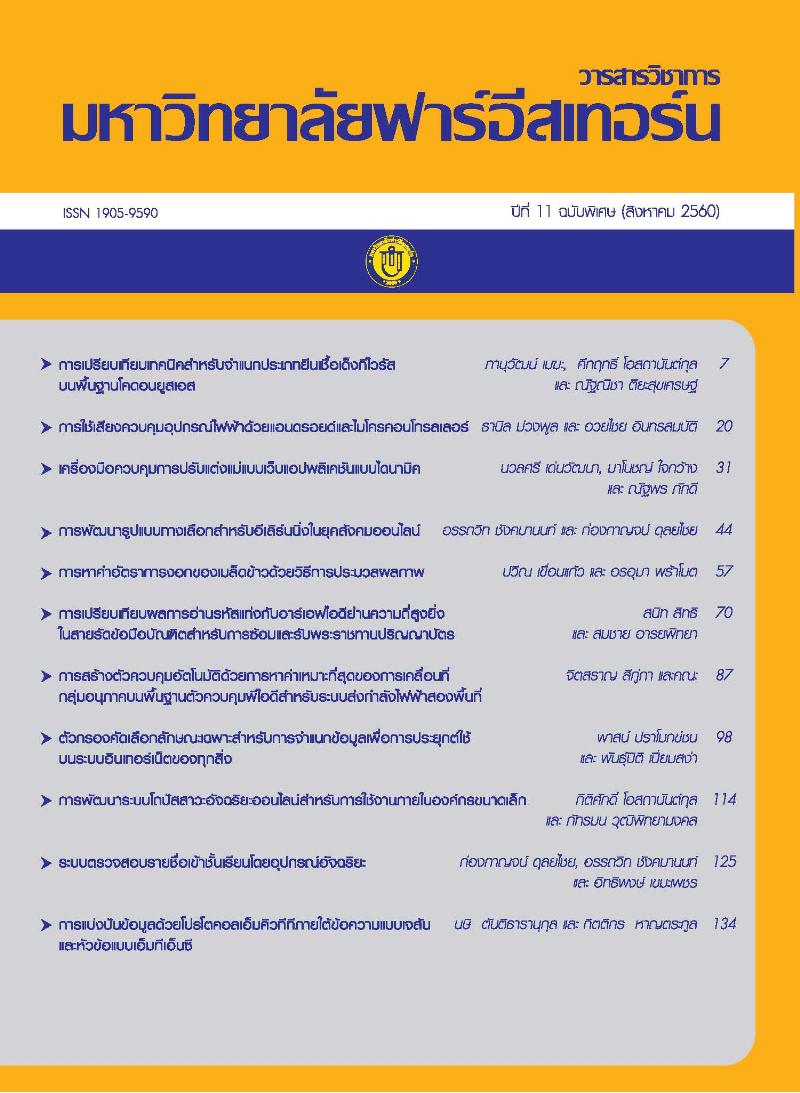การใช้เสียงควบคุมอุปกรณ์ไฟฟ้าด้วยแอนดรอยด์และไมโครคอนโทรลเลอร์
Main Article Content
Abstract
บทความนี้เป็นการนำเสนอการพัฒนาแอปพลิเคชันบนระบบปฏิบัติการแอนดรอยด์เพื่อควบคุม
อุปกรณ์ไฟฟ้าด้วยเสียง การพัฒนานี้ประกอบด้วยสองส่วนหลักได้แก่ สมาร์ตโฟนที่เป็นระบบปฏิบัติการ
แอนดรอยด์ทำหน้าที่ในการแปลงเสียงเป็นสัญญาณเพื่อไปควบคุมส่วนที่สอง คือ ไมโครคอนโทรลเลอร์
ทำหน้าที่ควบคุมการเปิด-ปิดอุปกรณ์ไฟฟ้า การวิจัยนี้แบ่งเป็นสองการทดลอง คือ (1) การหาประสิทธิภาพ
ของการแปลงเสียงโดยใช้สมาร์ตโฟนและอาร์ดูไอโน (Arduino) โดยใช้กลุ่มตัวอย่างที่แตกต่างกัน ทั้งเพศ
และอายุ จำนวน 30 คน ทดสอบการพูดผ่านสมาร์ตโฟนพร้อมกับส่งสัญญาณไปควบคุม Arduino
ผลการทดลองพบว่าในการแปลงเสียงมีความถูกต้องอยู่ที่ร้อยละ 94.67 (2) ใช้บอร์ด Raspberry Pi
เป็น ไมโครคอนโทรลเลอร์ ส่วนแอปพลิเคชันได้ทำการปรับแต่งให้มีความถูกต้องก่อนที่จะส่งสัญญาณ
ออกไปควบคุมอุปกรณ์ไฟฟ้าทำให้ผลการทดลองมีความถูกต้องทั้งหมดร้อยละ 100
In this paper, we design and develop an Android application in order to control electrical
devices using voice command. The development process of this research is divided into two parts,
including, (1) Android-base smart phone which its application can be developed easily, (2)
Microcontroller for remote controlled devices. In this paper, we conduct two experiments on our
application. First, the voice recognition accuracy is measured using a smart phone and Arduino.
We conduct the experiment on a variety of ages and genders of thirty people talking to the smart
phone in order to control the Arduino sensor. As a result, the accuracy of the voice recognition
system is high graded at 94.67%. Then, we use the recognized voice command to control a Raspberry
Pi microcontroller to turn on/off electrical devices. Our application can also munity the command
signal in order to improve the accuracy of the command. The result of the experiment shows that
the electrical devices can operated correctly.
Article Details
1. Any views and comments in the Journal of Social Innovation and Lifelong Learning are the authors’ views. The editorial staff have not to agree with those views and it is not considered as the editorial’s responsibility.
2. The responsibility of content and draft check of each article belongs to each author. In case, there is any lawsuit about copyright infringement. It is considered as the authors’ sole responsibility.
3. The article copyright belonging to the authors and The Far Eastern University are copyrighted legally. Republication must be received direct permission from the authors and The Far Eastern University in written form.
References
ธานิล ม่วงพูล อวยไชย อินทรสมบัติ และอาณัติ มณีโชติ. (2558). แอปพลิเคชันสำหรับการแปลงเสียงเป็นข้อความสำหรับผู้พิการทางหูโดยใช้ Google API. การประชุมวิชาการระดับชาติและนานาชาติ ประจำปี 2558. 3-4 ธันวาคม 2558, มหาวิทยาลัยราชภัฏอุตรดิตถ์. จังหวัดอุตรดิตถ์. 543-563.
บุรัสกร อยู่สุข คงเทพ บุญมี วรพันธ์ สาระสุรีย์ภรณ์ และนิติ วิทยาวิโรจน์. (2558). แอพพลิเคชันคำสั่งเสียงเพื่อเข้าสู่บทเรียนภาษาอังกฤษ. วารสารแม่โจ้เทคโนโลยีสารสนเทศและนวัตกรรม. 1(1), 55-60.
บุรัสกร อยู่สุข ภัทรวดี โควสุวรรณ และกฤษณุ อาศิรพัฒน. (2556). แอพพลิเคชันพจนานุกรมคําสั่งเสียงบนระบบปฏิบัติการแอนดรอยด์. การประชุมทางวิชาการระดับชาติด้านคอมพิวเตอร์และเทคโนโลยีสารสนเทศ ครั้งที่ 9. 9-10 พฤษภาคม 2556, มหาวิทยาลัยเทคโนโลยีพระจอมเกล้า พระนครเหนือ. กรุงเทพมหานคร. 973-978.
สำนักงานสถิติแห่งชาติ. [online]. สืบค้นเมื่อ 15 มีนาคม 2560, จาก http://www.nso.go.th.
AppBrain States. [online]. สืบค้นเมื่อ 15 มีนาคม 2560, จาก http://www.appbrain.com/stats/stats-index.
IDC. Smart phone OS market share. [online]. สืบค้นเมื่อ 15 มีนาคม 2560, จาก http://www.idc.com/ prodserv/smartphone-os-market-share.jsp.
Jiri Spale and Cedric Schweizer. (2016). Speech Control of Measurement Devices. IFAC-PapersOnLine 49-25 (2016) 013–018.
Youri Maryn, Femke Ysenbaert, Andrzej Zarowski, and Robby Vanspauwen (2016). Mobile Communication Devices, Ambient Noise, and Acoustic Voice Measures. Journal of Voice, Vol. 31, No. 2, pp. 248.e11–248.e23

